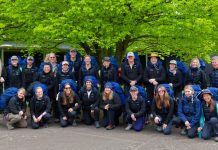Understanding the act of breathing can have a profound effect on the body, Lee Carsley says.

‘If we know the art of breathing, we have the strength and courage of ten tigers’
– old Chinese Proverb.
Recently, an Australian surfer, Mick Fanning, was attacked by a huge shark at a competition in South Africa. The shark caught the leg rope, pulling him under. The rope probably felt like a noose around its snout, because it immediately took flight. The interviews shortly after the attack had Mick gasping for air, barely able to put a sentence together. Where our breath goes, so it appears does our heart and mind – including the shark. Of all the benefits espoused by yoga, pranayama (breath) is one of its most profound. Besides improving our pulmonary function, breathing lifts our mood, and gives the brain necessary oxygen, without which we experience mental sluggishness, negative thoughts, and even depression. Most of us only notice how we breathe, when we have been surprised, get a cold, or regularly exercise.
What is breathing?
We breathe out carbon dioxide thousands of times a day – making breathing the most singularly effective toxic waste removal activity of our body. Our lungs are not muscles and cannot move on their own. They have three muscle choices. First, the muscles of the neck and upper torso (clavicular breathing). This breathing results in only small amounts of air. Most commonly seen in people who have lung illnesses, or asthma. Second, the muscle bands known as the intercostal muscles that lie between the ribs. This chest breathing seems natural for most of us. These muscles do give our body and lungs aerobic conditioning, but as we go about our day, chest breathing is considerably less dramatic – the ribs simply rise and fall with inhalation and exhalation, little air going in and out of the lungs. Thirdly, the diaphragm. These muscles create the greatest amount of control over our lungs for breathing. The diaphragm is a dome-shaped muscle lying horizontally inside the torso. This is the muscle we tend to use unconsciously when breathing every day, and not very well. Yoga teachersoften ask students to breathe in with the tummy – which technically you cannot do, but it is the general region of the diaphragm. Being able to use these muscles consciously are the secret to powerful life energizing breathing.
In and out through the nose, please…
We breathe in pairs, inhalation and exhalation. For most of us, inhalation is longer than exhalation. Much yogic pranayama is concerned with learning to control our breathing, which slows down metabolism, and calms the mind. So for everyday benefits, we advocate nose breathing.
And every move you make…
It takes practice, but this doesn’t take long because we are training our muscles to do what they naturally want to do. Every morning, sit on a chair, feet flat on the floor, body upright, arms relaxed and by your side. Close your eyes, and begin to breathe in and out through your nose. Mouth closed. Same count inhale and exhale. Get your breath even first. As you inhale, gently expand your tummy out. Feel the breath on the tip of your nose, moving down your throat, across your shoulders down your back to the bottom of your butt. On the exhale, feel your tummy relax. Do it all again.
Three to five minutes each day, and you are well on the way to a brighter, calmer you.
Lee Carsley is an executive coach and leadership expert-turned-yoga instructor, who currently runs ANZA’s yoga classes each week.







